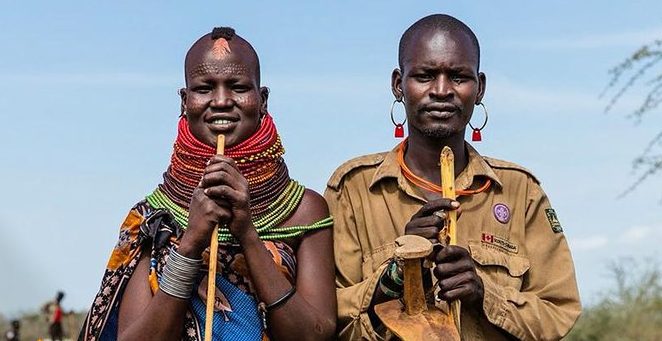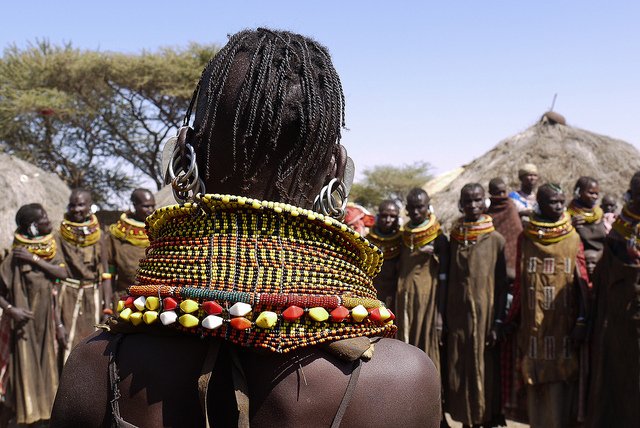Tribal groups in Karamoja sub-region : The Karamoja region of northeastern Uganda is bordered on the east by the Rift Valley escarpment that drops down into the Kenya territory of Turkana, on the north by the Sudan, on the south by the Mt. Elgon region, and on the west by the home territories of the Teso, Langi, and Acholi peoples. A large region of approximately 27,200 square kilometers, it is dominated by the large semi-arid landscape of its center, where there’s little or no rainfall, unpredictable, and too often sparse. In the north and south and along the eastern escarpment the land becomes more forested and mountainous, and in the west the area of the Labwor people is better watered.

The karamajong people are mainly nomadic pastoralists who rely on livestock in everything, although they also practice some bit of agriculture even though on their lands are semi- arid. They are known for their love for cattle and resistance to accessories of civilization. Due to the decades of remote cultural beliefs, the Karamojong’s people have been able to sustain their unique ancestral cultural heritages and customs for many years.
Currently, the Karamoja sub-region hosts 13 different tribes that really mans are all entered during the Nilotic migration and the typical people called the karamajong hey are only four including the mechanical of Moroto, the Bokora of Napak, the Nyakai of eastern side of Abim and the Piambe that are the four typical karamajong since other nine tribes are found within Karamoja sub-region are called karamajong. The principle ethnic group of Karamoja are classically identified within the Karamoja cluster includes; the Dodoth in the north, the Jie in the center and the karamajong in the center- south. However the karamajong are further sub- divided into three major regional and ethnic sub-groups and clans such as the Matheniko, Bokora and Pian. Other groups in the Karamajong Cluster outside of Karamoja are the Teso, the Turkana, and one or two smaller groups in southern Sudan. Because the Turkana have A Bibliography of Karamoja.
The Karamajong groups in Karamoja are all semi-nomadic pastoralists who also rely on seasonal horticultural production. An economically similar (although linguistically quite different) group, the Pakot or Suk, inhabits a territory in southeastern Karamoja that includes both Ugandan and Kenyan land. In western Karamoja is the relatively more fertile area of Labwor, where horticulture is the principal means of livelihood and the people are ethnically more similar to their Ugandan neighbors to the west. Several very small groups of ethnically marginalized people are also found literally on the fringes of Karamoja. The Tepeth or So are best known through the work of the Laughlins and Weatherby, while our information regarding the Teuso or Ik is sketchy and perhaps unreliable, and about the Nyakwai we know even less.
The most unique tribe in the Karamoja sub-region is the IK people are the indigenous community residing up on Mount Morungole in Kaabong district. the IK people are unique in a way that they are the indigenous settlers in Karamoja, Initially the Ik tribe were settled in lowlands of Karamoja region and later were forced into Karenga hill that bordering South Sudan and Kenya, however, due to conflicts and given that they were weaker in the tribal wars, they moved and settled on mount Morungole today travelers hike that mountain to visit this same group of people. They are farmers since the cattle were taken from them during the tribal wars in the region.

The cultural tours of Karamoja are best cultural experience to travelers varying from Karamoja village tours and the night with the karamajong nomadic warriors, and community visits. These are not only sightening experiences but a more practical experiences where visitor gets to interact with the local communities while they share their rich heritages. You also choose to spend a night in a traditional hut made of dry grass and cow dung and learn detailed exiting history of the karamajong people. travelers’ will also participate in various domestic activities while learning their economic activities like basket weaving , hut weaving, bead making n, clay sculpting and bee keeping . You also get to practice their daily life activities like preparing their local food and engage in their traditional dances.
Since the karamojongs are typical nomads, Kotido district has the largest nomadic group with large herds of cattle, you can experience the life of nomadic by sleeping with the warriors who later become cattle keepers in the kraal You also get to participate in their activities like milking the cows in the morning and learning how to identify local greens, learn traditions as spearing a cow for blood to drink and get your own karamajong name. The Karamoja entertainment is one of the unique traditional dance and music that should be experienced by everyone. The dance involves jumping up and down along with songs and dances is usually for marriage man wins a bride for himself. The karamajong have distinctive beauty ideals as scarification on the body and faces, usage of colorful beads and traditional shows.
Ways of life of the karamajong people
The karamajongs live in the house known as Manyata which are made of local materials such as dry grass, mud and cow dung. These houses are surrounded in a fence which consists of thorny plants to keep the animals from roaming and escape out of the fence and also a form of protection fro, dangers such as wild animal attack. The livestock kept by the karamojongs people include , cattle , goats, sheep and the products got from these animals includes ghee, meat, milk, skin and others. The karamajong were originally known as the jie people.
According to the karamajong people, a man is valued according to the number of heads of cattle he has. This is because of the fact that the karamajong highly depend on their animals for survival and a way of showing prestige. The move from one place to another in search for pasture and water for their prestigious animals.
This all can be seen during a vist to Kidepo valley national park. This is one of the remote national parks in Uganda and it is known for its uncommon wilderness and precious game viewing opportunity. Some of the wildlife in this national park cannot be seen from any of the national parks in Africa. Such wildlife include, the cheetahs, lesser kudu, lions, klipspringers, giraffes among others.
Bird species can also be seen in Kidepo valley national park and they include ostriches, little bee-eaters, red and yellow barbet, chestnut weaver, Jackson’s hornbill, greater kestrel, Karamoja apalis, among others.
Visiting the Karamoja people
The karamajong region can be accessed by both flights and road means. The long distance to this region is one of the factors that make the area remote.


